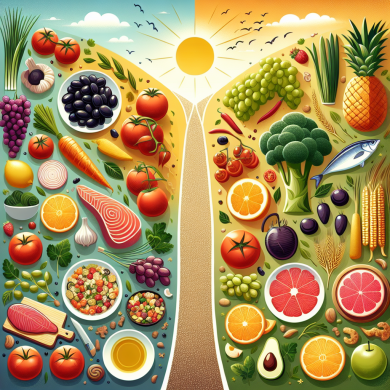### Boost Fiber Intake in Your DASH Diet Plan
Introduction to the DASH Diet
The DASH (Dietary Approaches to Stop Hypertension) diet is a dietary plan designed primarily to combat high blood pressure, but its health benefits go beyond that. It emphasizes the consumption of whole foods, such as fruits, vegetables, lean proteins, and whole grains, which are naturally rich in nutrients beneficial for heart health. Among these nutrients, fiber plays a critical role, contributing to both cardiovascular health and overall well-being.
The Importance of Fiber
Dietary fiber is a type of carbohydrate that the body cannot digest. While most carbohydrates are broken down into sugar molecules, fiber remains intact as it passes through the digestive system. This unique characteristic offers multiple health benefits, such as promoting digestive health, reducing cholesterol levels, balancing blood sugar, and aiding in weight management.
Fiber and the DASH Diet
The DASH diet naturally encourages a high intake of fiber-rich foods. By focusing on fruits, vegetables, whole grains, nuts, and seeds, the diet helps individuals meet the recommended daily intake of fiber. However, many people still fall short of these recommendations, which is why it’s essential to be mindful of fiber intake when following the DASH diet.
Recommended Fiber Intake
The American Heart Association recommends a daily fiber intake of 25 grams for women and 38 grams for men. However, most adults consume only about 15 grams per day. Increasing fiber intake to recommended levels can significantly enhance the health benefits of the DASH diet, particularly in terms of heart health and weight management.
Strategies to Boost Fiber Intake in Your DASH Diet Plan
1. Start Your Day with Fiber-Rich Breakfasts
Breakfast is an excellent opportunity to increase your daily fiber intake. Opt for high-fiber breakfast options such as oatmeal topped with fresh fruits and nuts, whole-grain toast with avocado, or a smoothie made with spinach, berries, and flaxseeds. These options provide a hearty dose of fiber and keep you fuller for longer, reducing the temptation to snack on less healthy foods throughout the day.
2. Choose Whole Grains
Whole grains are a fundamental component of the DASH diet and are much higher in fiber compared to refined grains. Incorporate whole-grain products like brown rice, quinoa, whole wheat pasta, and barley into your meals. When shopping, look for labels that specify “100% whole grain” to ensure you’re getting the most fiber.
3. Snack Smartly
Snacking can be an opportunity to add more fiber to your diet. Instead of reaching for chips or cookies, choose fiber-rich snacks such as air-popped popcorn, raw vegetables with hummus, or a handful of mixed nuts and seeds. These options not only satisfy hunger but also contribute to your daily fiber goals.
4. Load Up on Legumes
Legumes, including beans, lentils, and peas, are among the richest sources of dietary fiber. Incorporate these versatile ingredients into your meals by adding them to soups, stews, salads, or as a meat substitute in dishes like chili or tacos. A cup of cooked beans can provide up to 15 grams of fiber, significantly boosting your intake.
5. Increase Vegetable Intake
Vegetables are a cornerstone of the DASH diet and are excellent sources of dietary fiber. Aim to fill half your plate with a variety of colorful vegetables at each meal. Leafy greens, broccoli, Brussels sprouts, and carrots are particularly high in fiber. For added convenience, keep pre-cut vegetables in your refrigerator for quick snacks or additions to meals.
6. Incorporate Fruits Throughout the Day
Fruits are not only delicious but also high in fiber. Whole fruits are preferable to fruit juices, as they contain more fiber. Include fruits as part of your meals or as snacks. Berries, apples, pears, and bananas are excellent fiber-rich options. Remember to eat the skin where possible, as it contains additional fiber.
7. Experiment with Fiber Supplements
While it’s best to get fiber from whole foods, fiber supplements can be a helpful addition if you’re struggling to meet your daily requirements. Consult a healthcare provider before starting any supplement regimen, as they can offer guidance based on your specific health needs.
Benefits of Increased Fiber Intake
Improved Digestive Health
A diet high in fiber promotes healthy digestion by adding bulk to the stool and facilitating regular bowel movements. This can help prevent constipation and other digestive disorders.
Heart Health
Fiber, particularly soluble fiber, has been shown to lower cholesterol levels, which is beneficial for heart health. By adhering to a fiber-rich DASH diet, you can reduce your risk of cardiovascular disease.
Blood Sugar Control
Fiber helps slow the absorption of sugar, which can aid in maintaining stable blood sugar levels. This is particularly beneficial for individuals with diabetes or those at risk of developing the condition.
Weight Management
High-fiber foods are typically more filling, which can help control appetite and reduce overall calorie intake. This makes it easier to maintain a healthy weight or achieve weight loss goals.
Conclusion
Incorporating more fiber into your DASH diet plan is a simple yet effective strategy to enhance its health benefits. By being mindful of your food choices and making small adjustments to your meals and snacks, you can boost your fiber intake and reap the rewards of improved digestion, heart health, blood sugar control, and weight management. Consistently choosing fiber-rich foods not only aligns with the principles of the DASH diet but also supports a healthier, more balanced lifestyle.















Add comment